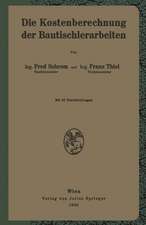Managing the Dynamics of New Product Development Processes: A New Product Lifecycle Management Paradigm
Autor Arie Karniel, Yoram Reichen Limba Engleză Paperback – 21 aug 2014
Within the framework, the methods used are enhanced or modified to fit the new-product development process requirements. Each specific method is exhaustively analyzed, from the basic definition of terms through a description of the state of the art of that topic and its limitations. Then, the method enhancements are illustrated by many examples, and discussed while suggesting further research directions. Finally, the enhanced methods are integrated and demonstrated by a test case. The main two methods described are the design structure matrix (DSM) and Petri nets, which are merged into a novel concept entitled DSM nets.
Managing the Dynamics of New Product Development Processes provides algorithms, proofs, and practical examples that can be used for general study of the issues concerned. The main concepts presented are applicable to systems engineering and can be used by practitioners of product development processes, such as designers, product managers, and process managers, as well as developers of process management tools for systems with dynamically changing process structures.
| Toate formatele și edițiile | Preț | Express |
|---|---|---|
| Paperback (1) | 943.73 lei 6-8 săpt. | |
| SPRINGER LONDON – 21 aug 2014 | 943.73 lei 6-8 săpt. | |
| Hardback (1) | 947.35 lei 6-8 săpt. | |
| SPRINGER LONDON – 28 iul 2011 | 947.35 lei 6-8 săpt. |
Preț: 943.73 lei
Preț vechi: 1150.89 lei
-18% Nou
Puncte Express: 1416
Preț estimativ în valută:
180.64€ • 196.28$ • 151.84£
180.64€ • 196.28$ • 151.84£
Carte tipărită la comandă
Livrare economică 21 aprilie-05 mai
Preluare comenzi: 021 569.72.76
Specificații
ISBN-13: 9781447161172
ISBN-10: 1447161173
Pagini: 280
Ilustrații: XX, 257 p.
Dimensiuni: 155 x 235 x 15 mm
Greutate: 0.4 kg
Ediția:2011
Editura: SPRINGER LONDON
Colecția Springer
Locul publicării:London, United Kingdom
ISBN-10: 1447161173
Pagini: 280
Ilustrații: XX, 257 p.
Dimensiuni: 155 x 235 x 15 mm
Greutate: 0.4 kg
Ediția:2011
Editura: SPRINGER LONDON
Colecția Springer
Locul publicării:London, United Kingdom
Public țintă
ResearchCuprins
1. Introduction.- 2. Managing Development Processes.- 3. Design Process Planning Using DSM.- 4. DSM Enhancements.- 5. Simulations.- 6. Process Modeling Using Workflow (WF)-nets.- 7. Logic Issues of DSM-based Processes.- 8. Dynamic New-Product Design Process (DnPDP).- 9. From DSM to DSM Net.- 10. Interpretation Using Implementation Rules and Business Rules.- 11. Dynamic Changes.- 12. Implementation Example.- 13. Summary.
Notă biografică
Dr. Arie Karniel is a system engineer working with CAD / PLM engineering information systems in various industries. He is responsible for developing methods and processes, for creating, transferring, and managing design knowledge to the shop floor. He is also a research scientist at Tel Aviv University and lectures on PLM courses. Arie has 18 years of experience working as a mechanical engineer, project manager, product manager and consultant in the aerospace, semiconductor, and software industries. He received his PhD in managing development processes knowledge from Tel Aviv University.
Prof. Yoram Reich worked as a designer/mechanical engineer, and has been doing research in design for over 25 years in Israel and the US. Yoram Reich is a full professor in the School of Mechanical Engineering, Tel Aviv University, where he directs the design and CAD track in the mechanical engineering undergraduate studies. He is the Editor-in-Chief of Springer’s major engineering design journal, Research in Engineering Design, and a board member of 5 others, as well as being co-chair of the Design Society SIG on design theory and an Advisory Board member of this society.
Prof. Yoram Reich worked as a designer/mechanical engineer, and has been doing research in design for over 25 years in Israel and the US. Yoram Reich is a full professor in the School of Mechanical Engineering, Tel Aviv University, where he directs the design and CAD track in the mechanical engineering undergraduate studies. He is the Editor-in-Chief of Springer’s major engineering design journal, Research in Engineering Design, and a board member of 5 others, as well as being co-chair of the Design Society SIG on design theory and an Advisory Board member of this society.
Textul de pe ultima copertă
Managing the Dynamics of New-Product Development Processes merges product-based planning, process modelling, process execution, probabilistic simulations, and simulation based decision-making into one framework called the Dynamic new-Product Development Process. It provides readers with a means of improving the management of product development through enhanced methods and tools that are specifically tailored to the characteristics and challenges of such processes. It calls for a new Product Lifecycle Management paradigm of utilizing the managed product data for management of the product's development process.
Within the framework, the methods used are enhanced or modified to fit the new-product development process requirements. Each specific method is exhaustively analyzed, from the basic definition of terms through a description of the state of the art of that topic and its limitations. Then, the method enhancements are illustrated by many examples, and discussed while suggesting further research directions. Finally, the enhanced methods are integrated and demonstrated by a test case. The main two methods described are the design structure matrix (DSM) and Petri nets, which are merged into a novel concept entitled DSM nets.
Managing the Dynamics of New Product Development Processes provides algorithms, proofs, and practical examples that can be used for general study of the issues concerned. The main concepts presented are applicable to systems engineering and can be used by practitioners of product development processes, such as designers, product managers, and process managers, as well as developers of process management tools for systems with dynamically changing process structures.
Within the framework, the methods used are enhanced or modified to fit the new-product development process requirements. Each specific method is exhaustively analyzed, from the basic definition of terms through a description of the state of the art of that topic and its limitations. Then, the method enhancements are illustrated by many examples, and discussed while suggesting further research directions. Finally, the enhanced methods are integrated and demonstrated by a test case. The main two methods described are the design structure matrix (DSM) and Petri nets, which are merged into a novel concept entitled DSM nets.
Managing the Dynamics of New Product Development Processes provides algorithms, proofs, and practical examples that can be used for general study of the issues concerned. The main concepts presented are applicable to systems engineering and can be used by practitioners of product development processes, such as designers, product managers, and process managers, as well as developers of process management tools for systems with dynamically changing process structures.
Caracteristici
Provides algorithms, proofs and usage examples that can be used for general study Presents the main concepts that are applicable to system engineering Includes methods that can be used by designers, product managers and process managers, as well as developers




























